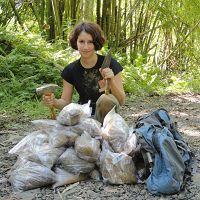Stone, 2013
Changes in extracellular enzyme activities and kinetics with depth across contrasting parent materials in the Luquillo Critical Zone
Stone M.M., Plante, A.F. (2013)
Ecological Society of America Conference 2013.
-
Luquillo, GRAD STUDENT
-
Christina, Luquillo, INVESTIGATOR, COLLABORATOR
Abstract
Background/Question/Methods
Extracellular enzymes in soils mediate the decomposition of organic matter and catalyze key transformations in carbon, nitrogen and phosphorus cycling. However, most studies of extracellular enzyme activity have focused exclusively on the upper 15 cm of the soil, despite the fact that microbial communities influence biogeochemical processes throughout the soil profile. The goal of this study was to determine how extracellular enzyme activity changes with depth in soils from two contrasting parent materials and forest types at the Luquillo Critical Zone Observatory (LCZO) in northeast Puerto Rico. We collected soils at 10 cm increments from the top of the A-horizon to a depth of 140 cm and measured total potential activities of six enzymes: α-glucosidase, β-glucosidase, β-xylosidase, cellobiohydrolse, N-acetyl glucosaminidase and acid phosphatase. The Michaelis-Menten kinetic parameters Vmax and Km were also measured for acid phosphatase.
Results/Conclusions
For all enzymes, total potential activity declined exponentially with depth. When normalized on a per unit carbon basis, however, only β-glucosidase and N-acetyl glucosaminidase declined significantly with depth (P<0.05). Vmax and Km both declined significantly with depth for acid phosphatase (P<0.001). We propose that changes in potential enzyme activity are controlled by changes in total biomass, while specific enzyme activity is governed by carbon quality and substrate availability. The observed decline with depth in both kinetic parameters for acid phosphatase suggests a tradeoff between maximal rate of substrate turnover (Vmax) and substrate binding affinity (Km). In tropical subsoils, microbial communities may be producing distinct isoforms of the phosphatase enzyme that are adapted to operating efficiently in a low organic-P environment.
Citation
Stone M.M., Plante, A.F. (2013): Changes in extracellular enzyme activities and kinetics with depth across contrasting parent materials in the Luquillo Critical Zone. Ecological Society of America Conference 2013. .
 This Paper/Book acknowledges NSF CZO grant support.
This Paper/Book acknowledges NSF CZO grant support.
Explore Further


